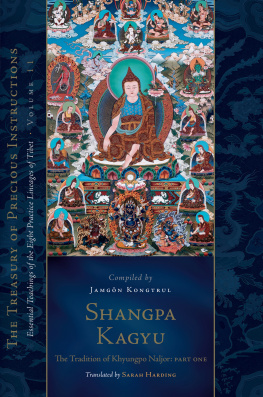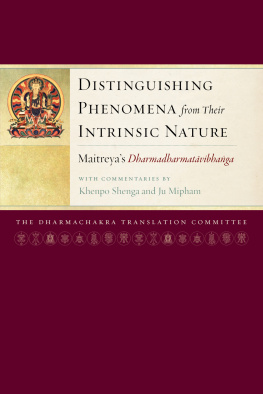
About Wisdom Publications
Wisdom Publications is the leading publisher of classic and contemporary Buddhist books and practical works on mindfulness. To learn more about us or to explore our other books, please visit our website at wisdompubs.org or contact us at the address below.
Wisdom Publications
199 Elm Street
Somerville, MA 02144 USA
We are a 501(c)(3) organization, and donations in support of our mission are tax deductible.
Wisdom Publications is affiliated with the Foundation for the Preservation of the Mahayana Tradition (FPMT).
Explore the nuances and depth of Buddhist practice with advice from celebrated ecumenical masters of Tibet.
For generations, Buddhist masters in Tibet have composed shaldam, poignant instructions tailored to the needs of their disciples in the form of short works of advice. Rare gems of wisdom, these works cover topics ranging from practicing while ill to meditating in solitary retreat to recognizing the nature of mind. This collection focuses on an influential and inspiring generation of Buddhist teachers during the nineteenth century in eastern Tibet who espoused an ecumenical, or rim, approach. A Gathering of Brilliant Moons provides lively translations of nineteen pithy and profound works by these great masters. In introductory essays, the translators explore the aesthetic qualities of these works, highlight their ecumenical features, and comment on the journey of translation.
With works from:
Jamgn Kongtrul
Dza Patrul Rinpoch
Ju Mipham Rinpoch
Dudjom Lingpa
The Third Dodrupchen
Do Khyents
Jikm Lingpa
Shardza Tashi Gyaltsen
Shangtn Tenpa Gyatso
Bamda Thupten Gelek Gyatso
Tokden kya r
Join Wisdoms mailing list and find out what to read next!
Receive the latest news and updates from Wisdom, including new releases and special offers.
Click here to sign up.

Facing Your Mind
Jamgn Kongtrul and Dudjom Lingpa
Translated by John Canti
Two Voices, One Message: Dont Look Elsewhere
I ndividuals at the highest levels of attainment in the Tibetan Buddhist world, whether in past centuries or more recent times, have by no means conformed to a uniform stereotype. Their lifestyles and personalities vary enormously. Indeed, according to Mahyna tradition, manifesting in a variety of forms to train beings according to their needs is how enlightenment should manifest at the emanational, nirmakya level. The texts I have translated here are by two authors with very different lifestyles. Both were great nineteenth-century masters masters primarily in the sense of prodigious spiritual accomplishment, but also in the sense of widely recognized literary skill. There, however, many of the obvious similarities end.
Jamgn Kongtrul Lodr Thay (181399) needs little introduction, for his is the first name that comes to most peoples minds at any mention of nineteenth-century ecumenical masters. He is undoubtedly one of the most important figures of the time. Steeped in learning, a lifelong monastic, with an established institutional role and widespread recognition, Kongtrul could hardly be more different than his younger contemporary, the visionary yogin and tertn Trakthung Dudjom Lingpa (18351904), who had a minimum of formal education, received little by way of teachings and transmissions (at least from human masters), and for much of his life led a materially precarious and peripatetic existence outside any formal affiliations, surrounded by his followers, consorts, and large family.
Descriptions of Kongtrul are so formal and laudatory that it is difficult to unearth details of his personality, but from his own autobiography and other writings, we get the impression of a dignified monk with immense learning worn lightly, great discipline, and a tendency to self-deprecation. He traveled widely but also spent long periods immersing himself in literary projects, performing retreats, and exchanging transmissions. Dudjom Lingpa, we know, was a physically powerful man, direct and uncompromising. A white-robed yogin with a mane of long hair, wearing large earrings, he is said to have had a presence that was both awe-inspiring and terrifying. He spent most of his life in a series of encampments and settlements, moving often but mostly within the confines of Mar, Ser, and Do, three river valleys of Golok in eastern Tibet.
Despite their undoubted differences, however, these two great masters had more in common than appearances might suggest. To start with, Kongtrul, too, was a visionary and a tertn. More important still, the overwhelming concern of both masters was the authentic use and transmission of the very essence of the Buddhist path in all its forms, and the fruit of that concern can be seen in the large cohorts of exceptionally accomplished practitioners that each of them trained, taught, or inspired.
Kongtrul and Jamyang Khyents Wangpo, of course, are the masters usually taken to be the origin of the nineteenth-century Buddhist renaissance in eastern Tibet that has become known as the rim nonsectarian or ecumenical movement. Kongtrul had seen for himself that without a change of perspective, Buddhism as practiced in the Tibet of his day was in danger of becoming a series of fossilized systems divided by sectarian bias and divorced from genuine spiritual experience. Worse, sectarian rivalry (often for patronage) had on occasions become a pretext for feuds, open conflict, and even warfare. In his own lifetime Kongtrul had seen at least three such periods of major upheaval. He and other contemporary lamas responded to this state of affairs with an openness and respect for the texts and transmissions of all authentic lineages of Tibetan Buddhism. They made extraordinary efforts to identify practices, texts, traditions, and lineages that were little known or in danger of extinction, to receive and study them, and to ensure their future transmission.
Combating sectarianism and resisting institutional hegemony was a major concern for Kongtrul and Khyents, and the impetus they created had far-reaching effects on many other masters of their time and afterward. But the fact that later observers called it the rim movement can give rise to an impression that nonsectarianism was its sole defining characteristic. In fact, renaissance seems a better term. The movement was, in essence, a broad-based return to truer Buddhist values. It may have been triggered by the specter of religious bigotry in an extreme and institutionalized form, but it had plenty of positive qualities to promote and not only negative trends to combat and resist.
Indeed, were anti-sectarianism alone taken as the criterion for belonging to this remarkable movement, Dudjom Lingpa would not qualify. He can hardly be described as ecumenical, working as he did entirely within his own revelations, which themselves were firmly based on the system of the Nyingma tantras and the Great Perfection. Geographically, too, while much of Kongtrul and Khyentss activity was centered on the region of Deg, Dudjom Lingpa, farther east in Golok, was an outlier who had little direct contact with the other masters identified with the phenomenon. What characterizes most of the masters identified with the rim movement is that they recognized the dangers of narrow scholasticism, of an overemphasis on institutional concerns, and of spiritual dishonesty in all its forms; in Dudjom Lingpas case, his whole life was a vigorous rebuttal of those impediments. He may not have been explicitly nonsectarian, but neither was he sectarian: his own tradition was entirely outside any established structure, and he did not promote it above any other. He saw it simply as the path on which his followers could attain enlightenment and this, according to all accounts, they did in droves. No less than thirteen of his disciples are known to have attained the rainbow-light body (
Next page











